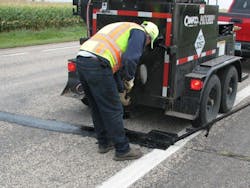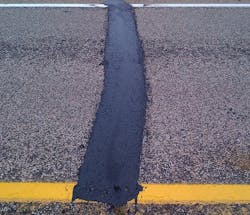The Problem
Depressed transverse cracks are a common issue on many roads. When this occurs, drivers experience a ride that is often described as driving over a washboard. Nicollet County has been treating depressed, transverse, and longitudinal cracks by spraying a tack coat, installing a fine hot mix, and then compacting. Normal crew size is approximately 8 to 10 people. It requires multiple trucks, a roller and all-day lane closure traffic control. Their production yield was typically mile per day at full road width. This method is very labor intensive and time consuming. The service life of a hot mix asphalt repair can be less than one year. This process has been used for many years and was determined to have limited application due to high-cost and significant traffic interruption.
The Solution
The County Road Department chose a highway that is used by cars, heavy trucks, and large farming vehicles to try Mastic One for the repair the depressed transverse cracks. Mastic One is specially designed for wide cracks and distressed surface areas, in both AC and PCCP pavements, that are too small for re-paving, but too large for crack sealant. Mastic One is a unique, hot-applied, polymer modified asphalt-based material with engineered aggregate. Mastic One is highly adhesive, flexible, durable and is waterproof with a service life exceeding 5 years.
The Project
Mastic One was applied with a shoe box applicator to a single lane at a time, utilizing a mobile operation with only flagmen for traffic control, thus limiting the time needed to divert traffic. The crew size was five, compared to 8-10, and each transverse crack took an average of 45 seconds to repair. Based on the ease and speed to apply Mastic One, a mile-long section of pavement was completed in approximately 2 hours and a single pallet (2,880 lbs.) was used.
The Results
Just 5 minutes after the application of the Mastic One, traffic was allowed to travel over the repair, making for a minimal interruption of normal traffic. The resulting ride was extremely smooth eliminating the thumps previously experienced at each crack. The County crew recognized that utilizing Mastic One to repair depressed transverse cracks resulted in less traffic interruption, less equipment and people required, lower cost and a better long-term repair. These benefits along with increased pavement smoothness and ride quality provided a great solution to a common road problem.
Editor's Note: Scranton Gillette Communications and the SGC Infrastructure Group are not liable for the accuracy, efficacy and validity of the claims made in this piece. The views expressed in this content do not reflect the position of the Roads & Bridges' Editorial Team.

